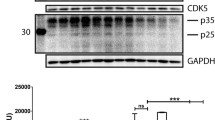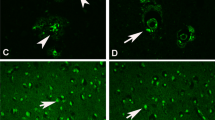Abstract
Aberrant metal homeostasis may enhance the formation of reactive oxygen species and Aβ oligomerization and may therefore be a contributing factor in Alzheimer’s disease. This study investigated the effect of chronic high intake of dietary Zn or Cu on brain metal levels and the accumulation and solubility of Aβ in vivo, using a transgenic mouse model that over expresses the C-terminal containing Aβ fragment of human amyloid precursor protein but does not develop amyloid deposits. Exposure to chronic high Zn or Cu in the drinking water resulted in only slight elevations of the respective metals in the brain. Total Aβ levels were unchanged although soluble Aβ levels were slightly decreased, without visible plaque formation, enhanced gliosis, antioxidant upregulation or neuronal loss. This study indicates that brain metal levels are only marginally altered by long term oral exposure to extremely high Cu or Zn levels, and that this does not induce Aβ-amyloid formation in human Aβ expressing, amyloid-free mice, although this is sufficient to modulate Aβ solubility in vivo.




Similar content being viewed by others
Abbreviations
- AD:
-
Alzheimer’s disease
- Aβ:
-
Amyloid β-peptide
- APP:
-
Amyloid precursor protein
- APP-C100:
-
The C-terminal fragment of amyloid precursor protein containing the Aβ peptide, also referred to as βCTF
- GFAP:
-
Glial fibrillary acidic protein
- NTg:
-
Non-transgenic
- SOD1:
-
Cu/Zn superoxide dismutase
- SDS:
-
Sodium dodecyl sulfate
- PBS:
-
Phosphate buffer saline
References
Aburto EM, Cribb AE, Fuentealba IC, Ikede BO, Kibenge FS, Markham F (2001) Morphological and biochemical assessment of the liver response to excess dietary copper in Fischer 344 rats. Can J Vet Res 65:97–103
Adlard PA, Cherny RA, Finkelstein DI, Gautier E, Robb E, Cortes M, Volitakis I, Liu X, Smith JP, Perez K, Laughton K, Li QX, Charman SA, Nicolazzo JA, Wilkins S, Deleva K, Lynch T, Kok G, Ritchie CW, Tanzi RE, Cappai R, Masters CL, Barnham KJ, Bush AI (2008) Rapid restoration of cognition in Alzheimer’s transgenic mice with 8-hydroxy quinoline analogs is associated with decreased interstitial Abeta. Neuron 59:43–55
Armendariz AD, Gonzalez M, Loguinov AV, Vulpe CD (2004) Gene expression profiling in chronic copper overload reveals upregulation of Prnp and App. Physiol Genomics 20:45–54
Atwood CS, Moir RD, Huang X, Scarpa RC, Bacarra NM, Romano DM, Hartshorn MA, Tanzi RE, Bush AI (1998) Dramatic aggregation of Alzheimer abeta by Cu(II) is induced by conditions representing physiological acidosis. J Biol Chem 273:12817–12826
Atwood CS, Huang X, Moir RD, Tanzi RE, Bush AI (1999) Role of free radicals and metal ions in the pathogenesis of Alzheimer’s disease. Met Ions Biol Syst 36:309–364
Atwood CS, Huang X, Khatri A, Scarpa RC, Kim YS, Moir RD, Tanzi RE, Roher AE, Bush AI (2000a) Copper catalyzed oxidation of Alzheimer Abeta. Cell Mol Biol (Noisy-le-grand) 46:777–783
Atwood CS, Scarpa RC, Huang X, Moir RD, Jones WD, Fairlie DP, Tanzi RE, Bush AI (2000b) Characterization of copper interactions with alzheimer amyloid beta peptides: identification of an attomolar-affinity copper binding site on amyloid beta1–42. J Neurochem 75:1219–1233
Barnham KJ, Bush AI (2008) Metals in Alzheimer’s and Parkinson’s diseases. Curr Opin Chem Biol 12:222–228
Barnham KJ, Masters CL, Bush AI (2004) Neurodegenerative diseases and oxidative stress. Nat Rev Drug Discov 3:205–214
Bayer TA, Schafer S, Simons A, Kemmling A, Kamer T, Tepest R, Eckert A, Schussel K, Eikenberg O, Sturchler-Pierrat C, Abramowski D, Staufenbiel M, Multhaup G (2003) Dietary Cu stabilizes brain superoxide dismutase 1 activity and reduces amyloid Abeta production in APP23 transgenic mice. Proc Natl Acad Sci USA 100:14187–14192
Bush AI (2000) Metals and neuroscience. Curr Opin Chem Biol 4:184–191
Bush AI, Multhaup G, Moir RD, Williamson TG, Small DH, Rumble B, Pollwein P, Beyreuther K, Masters CL (1993) A novel zinc(II) binding site modulates the function of the beta A4 amyloid protein precursor of Alzheimer’s disease. J Biol Chem 268:16109–16112
Bush AI, Pettingell WH, Multhaup G, d Paradis M, Vonsattel JP, Gusella JF, Beyreuther K, Masters CL, Tanzi RE (1994) Rapid induction of Alzheimer Aβ amyloid formation by zinc. Science 265:1464–1467
Cherny RA, Atwood CS, Xilinas ME, Gray DN, Jones WD, McLean CA, Barnham KJ, Volitakis I, Fraser FW, Kim Y, Huang X, Goldstein LE, Moir RD, Lim JT, Beyreuther K, Zheng H, Tanzi RE, Masters CL, Bush AI (2001) Treatment with a copper-zinc chelator markedly and rapidly inhibits beta-amyloid accumulation in Alzheimer’s disease transgenic mice. Neuron 30:665–676
Clements A, Allsop D, Walsh DM, Williams CH (1996) Aggregation and metal-binding properties of mutant forms of the amyloid Aβ peptide of Alzheimer’s disease. J Neurochem 66:740–747
Cunnane SC, McAdoo KR, Prohaska JR (1986) Lipid and fatty acid composition of organs from copper-deficient mice. J Nutr 116:1248–1256
Davis CD (1997) Effect of dietary zinc and copper on b-amyloid precursor protein expression in the rat brain. J Trace Elem Exp Med 10:249–258
Fischer PW, Giroux A, L’Abbe MR (1984) Effect of zinc supplementation on copper status in adult man. Am J Clin Nutr 40:743–746
George AJ, Holsinger RM, McLean CA, Laughton KM, Beyreuther K, Evin G, Masters CL, Li QX (2004) APP intracellular domain is increased and soluble Abeta is reduced with diet-induced hypercholesterolemia in a transgenic mouse model of Alzheimer disease. Neurobiol Dis 16:124–132
George AJ, Holsinger RM, McLean CA, Tan SS, Scott HS, Cardamone T, Cappai R, Masters CL, Li QX (2006) Decreased phosphatidylethanolamine binding protein expression correlates with Abeta accumulation in the Tg2576 mouse model of Alzheimer’s disease. Neurobiol Aging 27:614–623
Hensley K, Maidt ML, Yu Z, Sang H, Markesbery WR, Floyd RA (1998) Electrochemical analysis of protein nitrotyrosine and dityrosine in the Alzheimer brain indicates region-specific accumulation. J Neurosci 18:8126–8132
Huang X, Atwood CS, Moir RD, Hartshorn MA, Vonsattel JP, Tanzi RE, Bush AI (1997) Zinc-induced Alzheimer’s Abeta1–40 aggregation is mediated by conformational factors. J Biol Chem 272:26464–26470
Huang X, Atwood CS, Hartshorn MA, Multhaup G, Goldstein LE, Scarpa RC, Cuajungco MP, Gray DN, Lim J, Moir RD, Tanzi RE, Bush AI (1999) The A beta peptide of Alzheimer’s disease directly produces hydrogen peroxide through metal ion reduction. Biochemistry 38:7609–7616
Lee JY, Cole TB, Palmiter RD, Suh SW, Koh JY (2002) Contribution by synaptic zinc to the gender-disparate plaque formation in human Swedish mutant APP transgenic mice. Proc Natl Acad Sci USA 99:7705–7710
Li Q-X, Maynard C, Cappai R, McLean CA, Cherny RA, Lynch T, Culvenor JG, Trevaskis J, Tanner JE, Bailey KA, Czech C, Bush AI, Beyreuther K, Masters CL (1999) Intracellular accumulation of detergent-soluble amyloidogenic Aβ fragment of Alzheimer’s disease precursor protein in the hippocampus of aged transgenic mice. J Neurochem 72:2479–2487
Li QX, Mok SS, Laughton KM, McLean CA, Volitakis I, Cherny RA, Cheung NS, White AR, Masters CL (2006) Overexpression of Abeta is associated with acceleration of onset of motor impairment and superoxide dismutase 1 aggregation in an amyotrophic lateral sclerosis mouse model. Aging Cell 5:153–165
Massie HR, Aiello VR (1979) Changes with age in cadmium and copper levels in C57BL/6 J mice. Mech Ageing Dev 11:219–225
Matsuda A, Kimura M, Yokoi K, Kabata H, Itokawa Y, Kataoka M, Sato M (1989) Changes in trace-element concentrations after intravenous injection of an essential trace-element preparation for parenteral use in rats. Nippon Eiseigaku Zasshi 44:887–893
Maynard CJ, Cappai R, Volitakis I, Cherny RA, White AR, Beyreuther K, Masters CL, Bush AI, Li QX (2002) Overexpression of Alzheimer’s disease amyloid-beta opposes the age-dependent elevations of brain copper and iron. J Biol Chem 277:44670–44676
Maynard CJ, Bush AI, Masters CL, Cappai R, Li QX (2005) Metals and amyloid-beta in Alzheimer’s disease. Int J Exp Pathol 86:147–159
Miura T, Suzuki K, Kohata N, Takeuchi H (2000) Metal binding modes of Alzheimer’s amyloid beta-peptide in insoluble aggregates and soluble complexes. Biochemistry 39:7024–7031
Multhaup G, Schlicksupp A, Hesse L, Beher D, Ruppert T, Masters CL, Beyreuther K (1996) The amyloid precursor protein of Alzheimer’s disease in the reduction of copper(II) to copper(I). Science 271:1406–1409
Nunomura A, Perry G, Hirai K, Aliev G, Takeda A, Chiba S, Smith MA (1999) Neuronal RNA oxidation in Alzheimer’s disease and Down’s syndrome. Ann N Y Acad Sci 893:362–364
Olafson RW (1983) Intestinal metallothionein: effect of parenteral and enteral zinc exposure on tissue levels of mice on controlled zinc diets. J Nutr 113:268–275
Pappolla MA, Omar RA, Kim KS, Robakis NK (1992) Immunohistochemical evidence of oxidative [corrected] stress in Alzheimer’s disease. Am J Pathol 140:621–628
Perry G, Cash AD, Smith MA (2002) Alzheimer disease and oxidative stress. J Biomed Biotechnol 2:120–123
Pocino M, Malave I, Baute L (1990) Zinc administration restores the impaired immune response observed in mice receiving excess copper by oral route. Immunopharmacol Immunotoxicol 12:697–713
Pocino M, Baute L, Malave I (1991) Influence of the oral administration of excess copper on the immune response. Fundam Appl Toxicol 16:249–256
Pratico D, Uryu K, Leight S, Trojanoswki JQ, Lee VM (2001) Increased lipid peroxidation precedes amyloid plaque formation in an animal model of Alzheimer amyloidosis. J Neurosci 21:4183–4187
Sato I, Matsusaka N, Tsuda S, Suzuki T, Kobayashi H (1997) Effect of dietary zinc content on 65Zn metabolism in mice. J Vet Med Sci 59:1017–1021
Sayre LM, Zelasko DA, Harris PL, Perry G, Salomon RG, Smith MA (1997) 4-Hydroxynonenal-derived advanced lipid peroxidation end products are increased in Alzheimer’s disease. J Neurochem 68:2092–2097
Schoneich C, Williams TD (2002) Cu(II)-catalyzed oxidation of beta-amyloid peptide targets His13 and His14 over His6: detection of 2-oxo-histidine by HPLC-MS/MS. Chem Res Toxicol 15:717–722
Smith MA, Kutty RK, Richey PL, Yan SD, Stern D, Chader GJ, Wiggert B, Petersen RB, Perry G (1994) Heme oxygenase-1 is associated with the neurofibrillary pathology of Alzheimer’s disease. Am J Pathol 145:42–47
Smith MA, Hirai K, Hsiao K, Pappolla MA, Harris PL, Siedlak SL, Tabaton M, Perry G (1998a) Amyloid-beta deposition in Alzheimer transgenic mice is associated with oxidative stress. J Neurochem 70:2212–2215
Smith MA, Sayre LM, Anderson VE, Harris PL, Beal MF, Kowall N, Perry G (1998b) Cytochemical demonstration of oxidative damage in Alzheimer disease by immunochemical enhancement of the carbonyl reaction with 2, 4-dinitrophenylhydrazine. J Histochem Cytochem 46:731–735
Smith MA, Rottkamp CA, Nunomura A, Raina AK, Perry G (2000) Oxidative stress in Alzheimer’s disease. Biochim Biophys Acta 1502:139–144
Sparks DL, Schreurs BG (2003) Trace amounts of copper in water induce beta-amyloid plaques and learning deficits in a rabbit model of Alzheimer’s disease. Proc Natl Acad Sci USA 100:11065–11069
Sparks DL, Friedland R, Petanceska S, Schreurs BG, Shi J, Perry G, Smith MA, Sharma A, Derosa S, Ziolkowski C, Stankovic G (2006) Trace copper levels in the drinking water, but not zinc or aluminum influence CNS Alzheimer-like pathology. J Nutr Health Aging 10:247–254
Strozyk D, Launer LJ, Adlard PA, Cherny RA, Tsatsanis A, Volitakis I, Blennow K, Petrovitch H, White LR, Bush AI (2007) Zinc and copper modulate Alzheimer Abeta levels in human cerebrospinal fluid. Neurobiol Aging. Dec 6. [Epub ahead of print]
White AR, Reyes R, Mercer JF, Camakaris J, Zheng H, Bush AI, Multhaup G, Beyreuther K, Masters CL, Cappai R (1999) Copper levels are increased in the cerebral cortex and liver of APP and APLP2 knockout mice. Brain Res 842:439–444
White AR, Du T, Laughton KM, Volitakis I, Sharples RA, Xilinas ME, Hoke DE, Holsinger RM, Evin G, Cherny RA, Hill AF, Barnham KJ, Li QX, Bush AI, Masters CL (2006) Degradation of the Alzheimer disease amyloid beta-peptide by metal-dependent up-regulation of metalloprotease activity. J Biol Chem 281:17670–17680
Zhang H, Komano H, Fuller RS, Gandy SE, Frail DE (1994) Proteolytic processing and secretion of human β-amyloid precursor protein in yeast. Evidence for a yeast secretase activity. J Biol Chem 269:27799–27802
Acknowledgments
We thank Ms. Tina Cardamone for assisting with immunohistochemistry. This work was supported in part by grants from the National Health and Medical Research Council of Australia.
Author information
Authors and Affiliations
Corresponding author
Rights and permissions
About this article
Cite this article
Maynard, C.J., Cappai, R., Volitakis, I. et al. Chronic Exposure to High Levels of Zinc or Copper has Little Effect on Brain Metal Homeostasis or Aβ Accumulation in Transgenic APP-C100 Mice. Cell Mol Neurobiol 29, 757–767 (2009). https://doi.org/10.1007/s10571-009-9401-7
Received:
Accepted:
Published:
Issue Date:
DOI: https://doi.org/10.1007/s10571-009-9401-7




